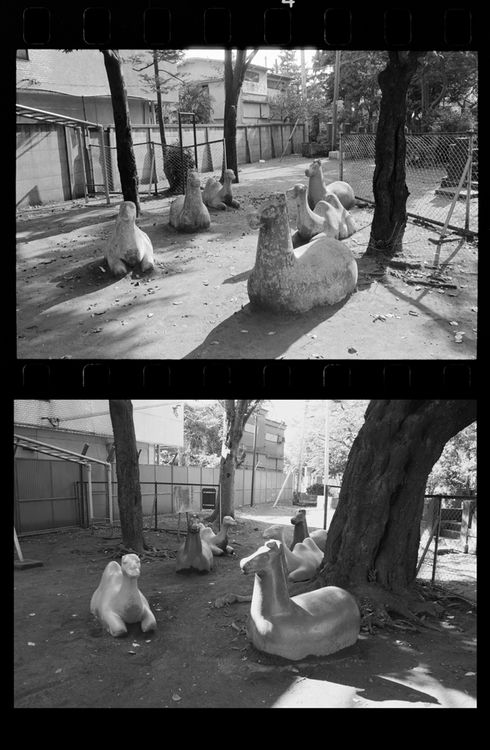|
eitoeiko is pleased to announce the group exhibition \'Football Exercise\' by Junta Egawa, Gil Kuno, Nipporini and Satoshi Uchiyama. In this exhibition, each artist is regarded as a football player. And the player handles black and white ball. Even though a half century has passed since the dawn of minimalism in art, can we find where the today\'s goal of the artist is?
Junta Egawa won the Tokyo Wonder Wall prize last year, and was selected by VOCA (the Vision of Contemporary Art, the Ueno Royal Museum, 2013) this spring. For those years Egawa has made focusing the abstract painting which was full of color. As his recent attempts to touch his unknown realm, Egawa is working with monochrome paintings. In his painting \'You are looking. I thought about somewhere far beyond.\', white and black collides and ashes are turned out. Egawa regards his painting as an unconscious scenery of everyday. It indicates the uncertainty that a daily life may be lost in an instant by big occurrences, such as an earthquake, a nuclear power plant disaster, a ballistic missile. Egawa knows his small, personal society is easily influenced by larger society. But at the same time the artist also knows that he can oppose from them. It appears spontaneously on canvas. In the square arena, the ogre battle which weaves the ring of creation and destruction fights again and again. In the other words, Egawa\'s painting is a recorded live broadcast which caught the light and the darkness of the society which changes continually.
\'Everything and Nothing\' by Zapf!(Gil Kuno and Laurel Bybee) is a cheerful object. It presents a Zen dialogue. When it switched ON, the universe appears. When it switched OFF, nothing appears except reality. The binomial confrontation was shown instantly by the light and darkness of light, as well as a synonymous subject called ON and OFF. \'Everything and Nothing\' shows both of the origin of the universe and the end of the world. So it may be an ultimate equipment of getting all the world. Satoshi Uchiyama changes a labor to a weight. In his \'It\'s growing up\', the thorough subordination to monotonous work of rolling a paper streamer returns to the white which means freedom. And new black one looks like a Giacometti\'s figure tried the diet further. The painting is made from paints of the material level exposed to the battle of fixing strength and gravity. The keen spectacle evokes the story of \'The spider\'s thread\' by Ryunosuke Akutagawa (1892-1927, Japan). So the thin black painting looks a prayer for the dead. What Uchiyama asks for art is a work, and is not a refinement. Uchiyama considers the artist\'s work is to lifting something against gravity, like a juggling a football. Nipporini uses a computer display instead of a film viewer in \'Solution\' for pointing an ironical solution to the problem between analogue and digital camera fans. Today, normally we can get to know the existence of vintage photographs by website at first. As an old-school photographer, it\'s sad and absurd, but Nipporini ventures to say make a smile to the new world. In Nipporini\'s \'Maturation\', the artist takes us from a past known as the present to a present known as the future. Nipporini splices together time as if he were connecting the first and last frames of a movie. Cityscapes taken by Jean-Eugene Atget (1857-1927, France) or Ihei Kimura (1901-1974, Japan) does not exist now. However, if we could go back in time only thirty years, we would be able to discover the enormous passage of time, and very substance of what we have lost. Trees become gigantic, tinplate become rusted, and buildings disappear and reproduce. All the cities mature. The only thing we can do is sit and wait in this cask as the whisky matures. In \'Maturation\', the artist attempts to call attention to a phenomenon which is often overlooked in everyday life. When we discover them, we realize that we ourselves are time travelers. This is the clock for those who travel in Alter Modern.
The black and white icosahedron ball for playing football called Telstar became popular in the 1960s. The outstanding visibility of Telstar was proved by the spread of color televisions. It sounds ironic, but, could be there synchronization between art and football? A lot of Japanese football players join major teams of the world today. Japanese artists can do well too? Please take notice of artists\' action which kicks a monochrome ball to win.
[作家プロフィール]
Junta Egawa (b.1978, Kanagawa)
2003 B.A. Japanese Painting, Tama Art University, Tokyo
2008 Shell Art Award, selected
2010 The 25th Holbein scholarship, scholar
2012 awarded the Tokyo Wonderwall Prize
2013 VOCA 2013, selected
Gil Kuno
2005 Japan Media Arts Festival, Tokyo, exellent prize
2012 Roppongi Art Night, Tokyo/ Fringe Festival, NYC
Exhibitions and performances internationally
Satoshi Uchiyama (b. 1978, Kanagawa)
2003 B.A. Japanese painting, Tama Art University, Tokyo
2005 M.A. Tama Art University, Tokyo
2011 The 26th Holbein Scholarship, scholar
Nipporini(b.1963, Tokyo)
2007 Between reality and fantasy, Waki Museum, Yamaguchi
2013 Shadow of consciousness, coordinated by Routes*Roots, Sibayo, Kyoto
Directed camera book \'Old lens paradise\' and others
Opening Reception: 17 May, 2013, 6PM-9PM
■ Contemporary Conversations 04
Experimental/ Noise/ Avantguard music in Tokyo, 2013
Masamichi Kinoshita(compose), Ken-ichi Tajima(bamboo flute), Kensuke Fujii, Tomoki Tai(Live electronics)
Guest: Gil Kuno
May 19(Sun) Open 3.30PM/Start 4PM
ADV 2,500JPY/ DOOR 2,800JPY
Produced by image/air and eitoeiko
全文提供:eitoeiko
会期:May 17(Fri) - June 15(Sat)
時間:12:00 - 19:00
closed on Sunday,Monday
会場:eitoeiko
|



